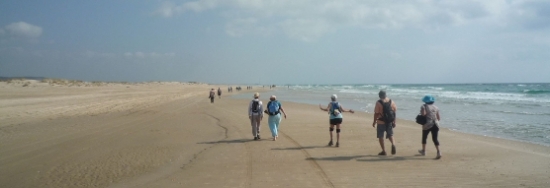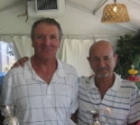
Where in the world can you walk ten miles along a gorgeous, mostly undeveloped beach?
In Israel, of course. We were on ESRA’s last hike of the season, along a northern section of Israel’s 170-mile long Mediterranean coastline, from Kibbutz Neve Yam near Atlit, south to Kibbutz Ma'agan Michael.
Once the site of a Crusader outpost, the village of Atlit was founded in 1903 with the help of philanthropist, Baron Edmond de Rothschild, who also financed the development of RishonLeZion and Caesarea, among many other projects.
In 1938, the British built a military camp at Atlit as a temporary holding camp for Jews who were attempting to immigrate to Palestine. Before and during WWII thousands of Jewish refugees fleeing Europe were detained in the camp. After the end of the war, Atlit was used to hold Holocaust survivors and other Jews deemed by the British to be illegal immigrants to Palestine. Most of these refugees arrived covertly on Aliyah Bet (clandestine immigration) voyages organized by the Mossad, utilizing ships manned primarily by volunteers from around the world. The detention camp remained in use until Israel’s independence and is now a national monument.
Trekking within a few yards of the sea, we soon discovered a dead loggerhead sea turtle. These turtles are common in the area, drawing tourists to observe their nocturnal ritual of burying their eggs in the sand. There are now about 100 female loggerhead turtles reproducing along Israel's coast on a regular basis. Unfortunately, nearly 200 injured or dead turtles wash up on Israel's shores every year. Scores of the turtles, which have a long life span of about 50 years, have been rescued by the nearby turtle rescue center at Michmoret.
We began to notice dark rocks along our route. Our excellent guide, Reuven, identified these formations as sandstone (kurkar). “There are three underwater sandstone ridges off the coast of Israel and another two on land. These sandstone ridges are unique in the world as a result of the way in which they were created: the sandstone ridges are fossilized sea-sand dunes. They run mainly parallel to the present-day coastline and mark the coastlines at different periods in the past.” (www.ecoocean.org)
We were near the cooperative settlement, Moshav Habonim, located on a sandstone ridge 80 feet above sea level. The Haifa-Tel-Aviv highway, beyond the moshav, was constructed precisely where an ancient highway once existed. When you drive by the site today, you can easily see the eastern wall of a Crusader fortress and the remains of a Byzantine village.
Before the Crusaders came to the area, there were Roman and Byzantine settlements. After the time of the Crusaders, Arabs arrived in the area. A small Arab village was built there and was demolished during Israel’s War of Independence. In 1985 there was a terrible train crash at Habonim in which 19 children and 3 adults on a school bus were killed. Ever since, the moshav has been associated with this tragic event.
As we walked, we were surrounded by beautiful, fragrant fields of purple thyme. The splendor was enhanced by the fact that, over time, the sea had eroded the beach leaving a small island of sandstone offshore. This feature of rocky islands was repeated on other beaches too. We were gratified to learn that the shoreline is protected as part of the Dor-Habonim Nature Reserve.
After crossing over the ridge, from which we had beautiful views in all directions, we came to the Blue Cave and then the Sandstone Quarry, both very photogenic spots. I was conscious of the warm breezes, the distant scenery, the blue-green sea, the rocks, the flowering thyme and a few fishermen with their long fishing rods. After passing the isolated Love Beach and the popular Nahsholim area, we arrived at Tel Dor, an archeological site and beach with abundant grottoes and ruins. “Tel” refers to a hill or built-up area, with one civilization built atop the remnants of the previous one.
The Tel Dor excavations have revealed 4,000 years of development. Dor was always strategically situated. It stood atop a rocky peninsula and was protected on its landward side by a marsh that formed a natural moat. Beyond the coastal lowlands are the Carmel Mountains. Dor was successively ruled by Canaanites, Sea Peoples, Israelites, Phoenicians, Assyrians, Persians, Greeks and Romans.
There is much history at the site. Ancient Dor was one of the important port cities of the Land of Israel. Its roots trace back to the Late Bronze Age. Dor was one of the cities inherited by the Tribe of Menashe, but the tribe never succeeded in asserting its rights there and they had to settle elsewhere. King Solomon's daughter, Tapheth, was married to Ben-Abinabad, Solomon’s officer, who presided over Dor (1 Kings 4:7-11). While warring against the Ottoman Turks in 1799, Napoleon’s army sank and/or buried their boats at Tantura (an Arab village built at Dor during Ottoman times and abandoned during the War of Independence), to prevent them from falling into enemy hands. Napoleon then led his army from Tantura towards Jaffa.
Baron Rothschild was active there too. “In 1891, the Baron financed the establishment of a bottle factory in Tantura, hoping to use the fine sand on the shore to manufacture glass bottles for the fledgling wine industry in Zichron Yaakov. A building was constructed under the supervision of Meir Dizengoff [later the first Mayor of Tel Aviv]. A French glass specialist was brought in, dozens of workers were hired and three ships were purchased to transport raw material and bottles.” (www.en.wikipedia.org) Nevertheless, the venture failed in 1895 and the factory was closed. Today, the building is an archeological museum. It is situated on Kibbutz Nahsholim, and built on what, in 1948, was Tantura.
We continued our five-hour walk along the magnificent beach and finished where our guide Reuven lives, Kibbutz Ma'agan-Michael. There we relaxed, swam, showered and enjoyed a tasty barbecue. A great time was had by all.
This great recreation area is only 90 minutes from home. Although we hadn’t been on the Nahsholim beach for 20 years, we returned just two days later with friends to swim and enjoy the sunset. Because of the sandstone rock islands visible offshore, we were reminded of the beautiful beaches at Thailand’s Andaman Sea, high praise indeed. Our pleasure was extended when we drove to nearby Zichron Yaakov (another town indebted to the Baron) for a delicious dinner. Where in the world? Israel!
Go to www.esra.org.il for an extensive calendar of events suitable for both locals and tourists.
 ESRA Golf Competition 2012
ESRA Golf Competition 2012 Upside-Down Coffee – for another world. A Review
Upside-Down Coffee – for another world. A Review If I could tell you - a review
If I could tell you - a review A new website in English - on Volunteering - Launched in Israel
A new website in English - on Volunteering - Launched in Israel Help Needed for Abused Horses and Donkeys
Help Needed for Abused Horses and Donkeys Heather's Heseg
Heather's Heseg Steve Kramer
Steve Kramer